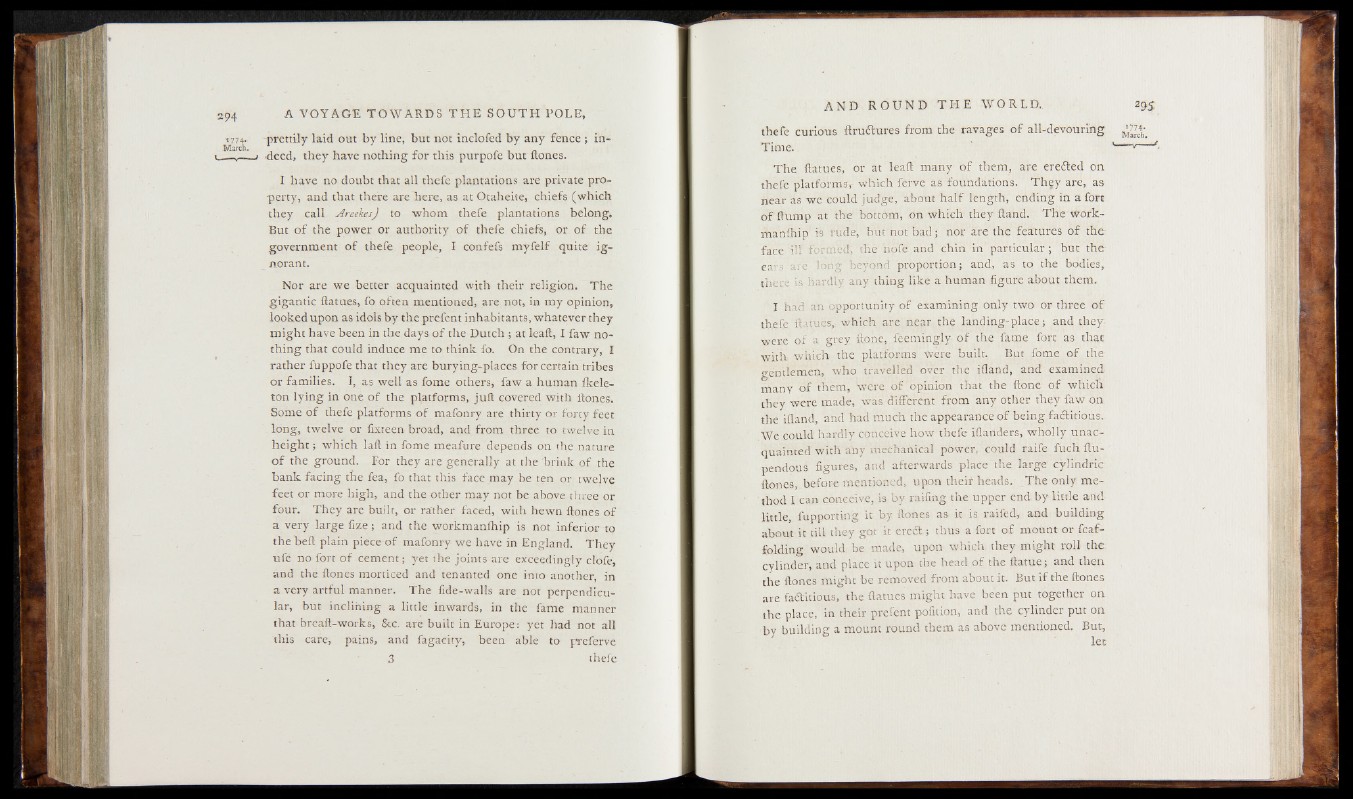
1774. -prettily laid oat by line, but not inclofed by any fence j in-
__1_i .deed, they have nothing for this purpofe but ftones.
I have no doubt that all thefe plantations are private property,
and that there arefhere, as at Otaheite, chiefs (which
they call Areekes) to whom thefe plantations belong.
But of the power or authority of thefe chiefs, or of the
government of thefe people, I confefs myfelf quite ignorant.
Nor are we better acquainted with their religion. Thé
gigantic ftatues, fo often mentioned, are not, in my opinion,
looked upon as idols by the prefent inhabitants, whatever they
might have been in the days of the Dutch ; at lead, I faw nothing
that could induce me to think fo. On the contrary, I
rather fuppofe that they are burying-places for certain tribes
or families. I, as well as fome others, faw a human Ikele-
ton lying in one of the platforms, juft covered with ftones.
Some of thefe platforms of mafonry are thirty or forty feet
long, twelve or fixieen broad, and from three to twelve in
height; which laft in fome meafure depends on the nature
of the ground. For they are generally at the brink of the
bank facing the fea, fo that this face may be ten or twelve
feet or more high, and the other may not be above three or
four. They are built, or rather faced, with hewn ftones of
a very large fize; and the workmanlhip is not inferior to
the beft plain piece of mafonry we have in England. They
ufe no fort of cement; yet the joints are exceedingly clofe,
and the ftones morticed and tenanted one into another, in
a very artful manner. The fide-walls are not perpendicular,
but inclining a little inwards, in the fame manner
that breaft-works, &c. are built in Europe: yet had not all
this care, pains, and fagacity, been able to preferve
3 thefe
AND ROUND TH E WORLD. 295
thefe curious ftructures from the ravages of all-devouring
Time. *----*--- ‘
The ftatues, or at leaft many of them, are erected on
thefe platforms,- which ferve as foundations. They are, as
near as we could judge, about half length, ending in a fort
of flump at the bottom, on which they ftand. The work-
manfhip is rude, but not bad; nor are the features of the-
face ill formed, the nofe and chin in particular; but the-
ears are long beyond proportion; and, as to the bodies,
there is hardly any thing like a human figure about them.
I had an opportunity of examining only two or three of
thefe ftatues, which are near the landing-place; and they;
were of a grey ftone, feemingly of the fame fort as that
with which the platforms were built. But fome of the
gentlemen, who travelled over the ifland, and examined,
many of them, were of opinion that the ftone of which
they were made, was different from any other they faw on
the ifland, and had much the appearance of being factitious.
We could hardly conceive how thefe iflariders, wholly unacquainted
with any mechanical power, could raife fuch ftu-
pendous figures, and afterwards place the large cylindric
ftones, before mentioned, upon theif heads. The only method
I can conceive, is by raffing the upper end by little and
little, fupporting it by ftones as- it is raifed, and building
about it till they got it erect ; thus a fort of mount or fcaf-
folding would be made, upon which they might roll the
cylinder, and place it upon the head of the ftatue; and then
the ftones might be removed from about it. But if the ftones
are factitious, the ftatues might have been put together on
the place, in their prefent pofition, and the cylinder put on
by building a mount round them as above mentioned. But,